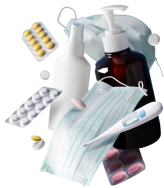Healthwire Pharmacy provides 100% genuine medicines straight to your doorstep.
Order Now! & Avail
Upto 10% OFF On All Your Pharmacy Orders!
Diclofenac Potassium 75mg
Healthwire Pharmacy Ratings & Reviews (1500+)
Product Information
Diclofenac Potassium, a non-steroidal anti-inflammatory drug (NSAID), exerts its primary mechanism of action by inhibiting the enzyme cyclooxygenase (COX). This enzyme exists in two forms COX-1 and COX-2. Diclofenac selectively inhibits COX-2, which is responsible for the production of prostaglandins that mediate pain, inflammation, and fever. By blocking COX-2, diclofenac reduces the formation of these prostaglandins, thereby alleviating pain and inflammation associated with various conditions. It primarily targets the site of inflammation, providing relief without significantly affecting the production of protective prostaglandins in the stomach, which is associated with COX-1. This selective inhibition contributes to its therapeutic effects in managing pain and inflammation while potentially minimizing gastrointestinal side effects associated with non-selective COX inhibition.
Diclofenac Potassium 75mg
Non-steroidal anti-inflammatory drug (NSAID)
Tablet
The following are the uses of Diclofenac Potassium 75mg Tablet:
In the case of an overdose of Diclofenac Potassium 75mg Tablets, individuals may experience symptoms such as nausea, vomiting, abdominal pain, and in severe cases, gastrointestinal bleeding. The severity of the overdose effects can vary depending on the amount ingested. It is important to seek medical advice promptly if an overdose is suspected, as healthcare professionals can provide appropriate treatment and support to manage any adverse effects and ensure the individual's well-being.
In the case of a missed dose of Diclofenac Potassium 75mg Tablet, it is important to take the medication as soon as you remember. However, if it is almost time for your next dose, skip the missed dose and continue with your regular dosing schedule. Do not double the dose to make up for a missed one, as this may increase the risk of side effects. If you miss multiple doses, contact your healthcare provider for guidance on how to safely resume your medication and maintain its effectiveness. It is generally recommended to take the missed dose within a 2-3 hour window of the scheduled time.
To take Diclofenac Potassium 75mg Tablet, swallow the tablet whole with a full glass of water, preferably with or after a meal, once or twice a day as directed by your doctor.
Following are the conditions when Diclofenac Potassium 75mg Tablet should not be used:
The side effects of Diclofenac Potassium 75mg Tablet may include:
Following are the precautions and warnings for Diclofenac Potassium 75mg Tablet:
Following are the drug interactions for Diclofenac Potassium 75mg Tablet:
Following are the food interactions for Diclofenac Potassium 75mg Tablet:
Diclofenac Potassium 75mg Tablets should be stored in a cool and dry place, preferably at room temperature, ensuring protection from light and moisture. The original container should be tightly sealed to maintain its integrity and prevent contamination. It is crucial not to store the tablets in the bathroom or near heat-emitting appliances to safeguard against temperature-induced degradation. Proper disposal is essential; never flush or pour the medication down the drain. Consult your pharmacist or healthcare professional for appropriate disposal guidelines. Keep the tablets out of children's reach to prevent accidental consumption, and always exercise caution when handling and storing this medication.
Following are the quick tips for Diclofenac Potassium 75mg Tablet:

Order Now! & Avail
Upto 10% OFF On All Your Pharmacy Orders!

If you face any issue, feel free to contact us. We provide 24/7 support to assist your problems